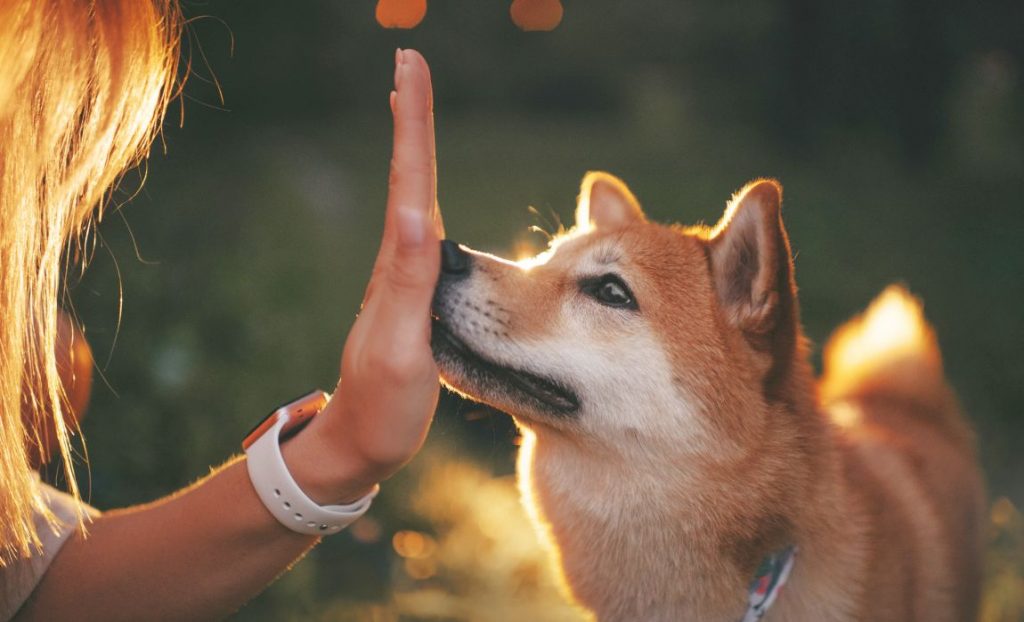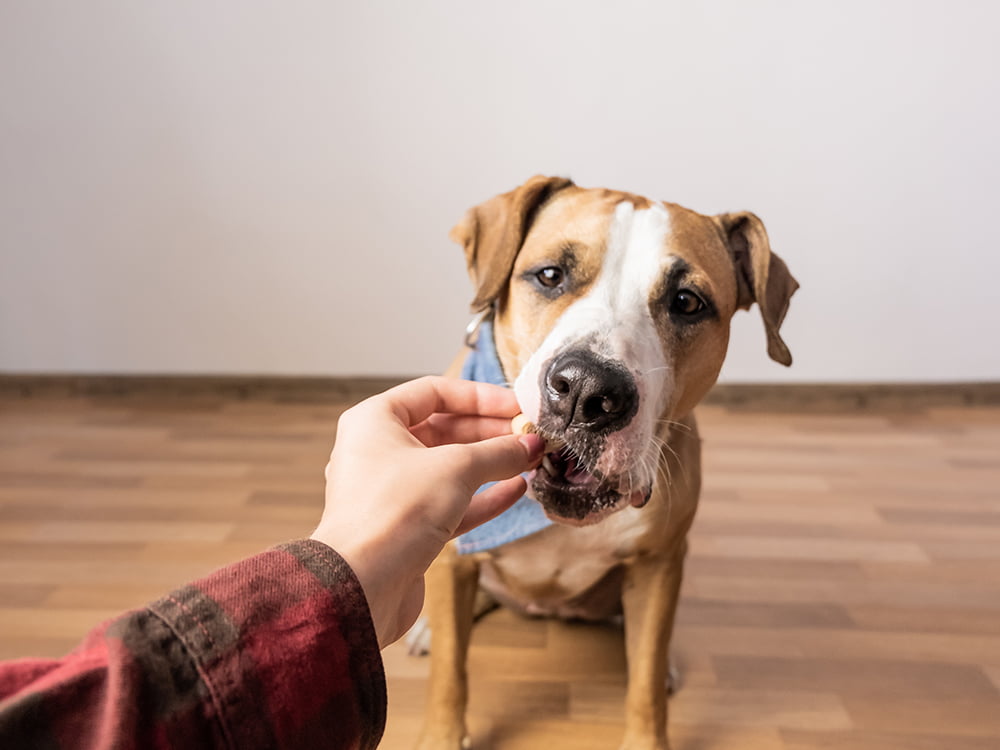Targeting is a fun game you can play with your dog that keeps their focus on a target of your choice. When we use the word ‘targeting’ in dog training, we mean giving the dog a target to aim for, such as our hand or a mat, that we would like them to go directly to and touch with a specific part of their body, such as their nose or a paw!
Teaching your dog to place a part of their body on a target and hold it there can be used in lots of different ways, and it helps to build their confidence as well as their trust in us! It can be a really enjoyable activity for dogs because they have the opportunity to use their brainpower as well as getting lots of rewards!

Teaching your dog to touch your hand can help them understand that human hands are great! This can build confidence around humans in dogs who might be a little shy and can help with grooming too – essential for longer-haired dogs! Targeting is also a way to move your dog around hands-free, as you can teach them to follow your hand, so you don’t need to push or pull them into places or positions, such as sitting on the vet’s weighing scales. This means they can trust you, and your hands are always seen as good things.
Teaching your dog to place their paws onto a mat can help them out at the vets as you can simply pop their mat onto the weighing scales and they’ll confidently step onto it, knowing they always get a tasty treat for doing so!
Targeting can also help your dog focus on you rather than distractions, such as other dogs or people, including joggers or cyclists, when you’re out and about. Once your dog has learned that following and touching a target is always thoroughly enjoyable and rewarding for them, they will want to focus on that and ignore potentially scary or tempting things.
Before you start any training, your dog needs to be in a familiar environment that is calm and quiet, so you know they are starting off feeling happy and relaxed and will be able to concentrate. Decide on a short marker word, such as “yes” or “fab” that tells your dog that what they are doing is exactly what you want. Teach your dog this is the special word that will earn them a treat by saying the word “fab” and then giving them a treat straight away, every time. Your dog will soon learn that “fab” = treat! You’ll also need lots of tiny pieces of very tasty treats that your dog loves.
 Begin by rubbing a piece of food on your hand so your dog can smell it. If they watch you doing this, they should naturally be interested in your hand! When your dog sniffs and touches your hand with their nose, ‘mark’ this moment exactly when it happens by saying your special marker word and then giving them a treat. Repeat this several times, remembering to always mark the behavior with your word and give the treat instantly.
Begin by rubbing a piece of food on your hand so your dog can smell it. If they watch you doing this, they should naturally be interested in your hand! When your dog sniffs and touches your hand with their nose, ‘mark’ this moment exactly when it happens by saying your special marker word and then giving them a treat. Repeat this several times, remembering to always mark the behavior with your word and give the treat instantly.
Don’t reward your dog with a treat if they mouth, paw, or bark at you, as this may mean they are becoming confused or frustrated. There’s no need to rush so go at your dog’s pace as this will give them confidence, and ensure the training is fun! If your dog appears to struggle at any point simply go back to a stage at which they were doing well and repeat that for a little longer.
When your dog is consistently touching their nose to your hand as you hold it out, add a special word to this action – most trainers say “touch” as it’s easy to remember! First of all, say this word the moment that your dog makes contact with your hand so that they learn to connect their action with this word. Repeat this every time you practice so that your dog learns that when you say “touch”, the quicker they touch your hand with their nose, the quicker they’ll hear you say your marker word, and then give them the treat!
You’ll find that over time you can start to say the word “touch” as soon you start to hold out your hand to your dog, because they have learned that it means that you want them to touch your hand, and there’s a treat in it for them when they do!
The next step is for your dog to keep touching your hand with their nose for a little longer. 
Encourage them to do this by waiting slightly, just a second to begin with when they make contact with you before marking and rewarding them. Once your dog is consistently keeping their nose on your hand for one second before hearing the marker word and getting their treat, hold on a little longer still, so for two seconds now, before saying the marker word and giving the treat. Repeat every small step several times, so your dog can be confident that to keep touching you is what you want, and then very gradually use this technique to slowly increase the length of time they will remain touching you!
When your dog can reliably wait for five seconds while touching your hand with their nose, introduce a very slight distraction, for instance, hold a bit of kibble or a toy (but not their favorite, don’t make it too hard!) in your other hand. Hold your target hand out and ask for the “touch”, and if they touch your hand with the distraction present, mark and reward with an extra tasty treat.
Now you can try practicing in different places but be prepared to repeat some of the early steps while your dog adjusts to all the distractions of the great outdoors! Remember, the more distractions around, the harder it might be for your dog, so keep sessions short and fun with lots of tasty treat rewards.
Once your dog has learned that touching your hand is thoroughly rewarding, you can use this in situations that might naturally be a little more uncomfortable for your dog, such as grooming. Grooming while your dog is targeting your hand means they can be absolutely confident that it is worth their while and nothing to worry about because they will have trust and faith in what you are doing, as long as you take time to introduce it in a gradual and fun way!
Once your dog can happily hold their nose to your hand for a few seconds, introduce a gentle stroke to your dog’s side while they are still targeting your hand. Your aim is to get your dog to stay on target while you stroke their body, so start by gently stroking them for a very brief second and then say your marker word and reward them. Progress this by gradually lengthening the duration of the stroke, all while your dog is still holding their nose to your hand.
Once your dog is doing this happily you can then start introducing a brush. Make sure your dog isn’t worried by the object, to begin with, and when you introduce the brush, start the same way you introduced your hand with very light, short strokes. Gradually increase the length of time and brushstroke. Should your dog remove their nose from your hand at any point just go back and practice for a little while longer at an easier stage.
Your dog should always appear happy to engage with you and the training sessions. If your dog appears to want to avoid the training, then you may be going too quickly for them. Even if they’re doing well, they need to learn at their own pace!
Don’t worry if your dog gets something wrong, there’s no need to say ‘no’ or get upset, just remember to be consistent and clear so you don’t confuse them. It’s all part of the learning process, as they find out what gets them the treat and what doesn’t.
Keep training sessions short and simple so they’re always fun. Remember you are competing with distractions that may make it difficult for your dog to focus. Gradually introducing distractions is the way to go!
If your dog is short and/or you find it difficult to bend you can use a wooden spoon instead of your hand and teach your dog to place their nose on that when you hold it out to them.
Als u deze pagina nuttig vindt, overweeg dan alstublieft een kleine donatie achterlaten om ons te helpen nuttiger advies te creëren.
Dat kan ook meld u aan voor onze gratis nieuwsbrief voor meer tips en trucs en om op de hoogte te blijven van ons werk.
| Koekje | Duur | Beschrijving |
|---|---|---|
| cookielawinfo-checkbox-analytics | 11 maanden | This cookie is set by GDPR Cookie Consent plugin. The cookie is used to store the user consent for the cookies in the category "Analytics". |
| cookielawinfo-checkbox-functioneel | 11 maanden | The cookie is set by GDPR cookie consent to record the user consent for the cookies in the category "Functional". |
| cookielawinfo-checkbox-noodzakelijk | 11 maanden | This cookie is set by GDPR Cookie Consent plugin. The cookies is used to store the user consent for the cookies in the category "Necessary". |
| cookielawinfo-checkbox-anderen | 11 maanden | This cookie is set by GDPR Cookie Consent plugin. The cookie is used to store the user consent for the cookies in the category "Other. |
| cookielawinfo-checkbox-prestaties | 11 maanden | This cookie is set by GDPR Cookie Consent plugin. The cookie is used to store the user consent for the cookies in the category "Performance". |
| bekeken_cookie_beleid | 11 maanden | De cookie wordt ingesteld door de AVG Cookie Consent-plug-in en wordt gebruikt om op te slaan of de gebruiker al dan niet toestemming heeft gegeven voor het gebruik van cookies. Er worden geen persoonlijke gegevens opgeslagen. |
Maak een account aan of log in om huisdieren waarvan u houdt te redden.
Heeft u geen account? Neem contact met ons op
Voordat u doorgaat met uw adoptieaanvraag, dient u onze gegevensverwerkingspraktijken te lezen en te accepteren:
Opmerking: By clicking "I Agree & Continue", you will be redirected to an external application form. This tracking system logs your interest but does not capture data from the external form.
Maak een account aan of log in om huisdieren waarvan u houdt te redden.
Heeft u geen account? Neem contact met ons op
Voordat u doorgaat met uw adoptieaanvraag, dient u onze gegevensverwerkingspraktijken te lezen en te accepteren:
Opmerking: By clicking "I Agree & Continue", you will be redirected to an external application form. This tracking system logs your interest but does not capture data from the external form.